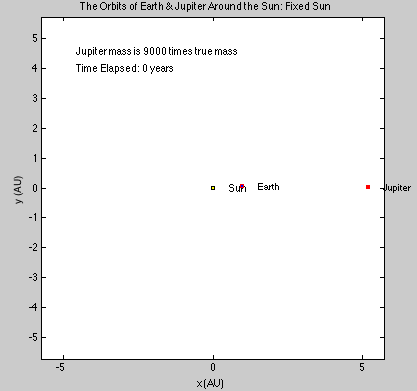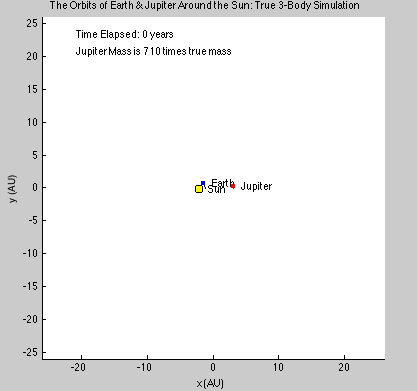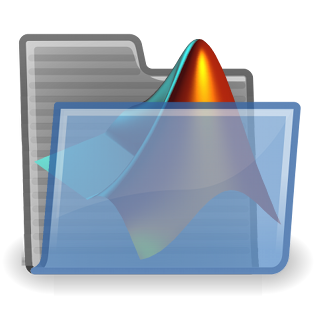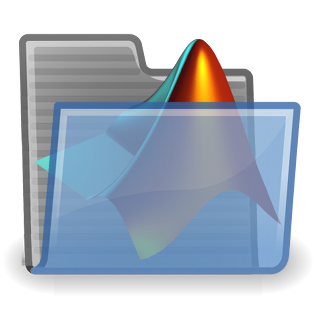Nadav Hendel & Matteo Bjornson
Week Two
The celestial two body problem can be solved exactly, allowing us to observe Kepler’s Laws in action, but the same is not always true of the three-body case. Thus, solving the three body problem exactly has been a central problem of celestial mechanics. In this section, we model the effect of adding a third planet into our system. We will use Jupiter, since it has the largest mass of the planets and therefore would have the most significant effect on the Earth and Sun. The planetary motion will still be related using the inverse square law for gravitational force, and the sun will still be fixed to the origin for our first routine Jupiter-Earth.
Jupiter-Earth is very similar to our first routine Planets, in terms of methodology. For each time step, the planets positions are calculated using the Euler-Cromer method. This is completed by keeping track of the distances between both planets and the sun, as well as the interplanetary distance. From these distances, we can compute the acceleration of each planet as related by the inverse square law, and from there, the new positions. The code for this program is quite dense, and as noted in the textbook, it can be more efficient to define some recurring variables at the beginning of the code such that they need not be recalculated during each iterative loop. Despite this we opted not to do this in our code for the sake of clarity since this added efficiency is quite small.
From our initial results running this program, we can see that using normal masses for Earth and Jupiter, stable planetary orbits can be achieved. At this point, we will continue our experimentation by observing how a change in Jupiter’s mass would affect the Earth’s orbit. As an initial point of reference, a small increase of ten fold of Jupiter’s mass yields negligible results, as Jupiter’s mass is still dwarfed by that of the sun.
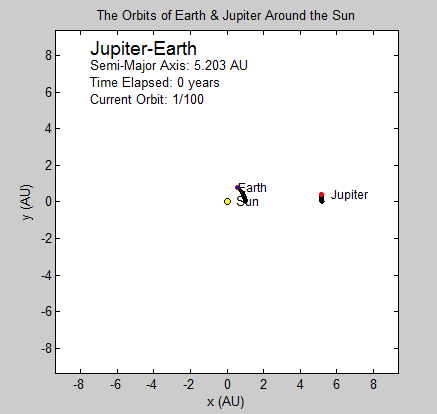
In the textbook, a mass increase of 1000 fold is supposed to yield much larger changes in the earths orbit. Unfortunately, we were not able to achieve this result exactly, and were only able to note significant changes using a mass of closer to times 9000 Jupiter original mass. The results of this are shown below:
The fact that we had to increase the mass of Jupiter to 9000 to observe noticeable changes in earth’s orbit indicates that we may still have some bugs in our code that need correcting. According to Giordano, these effects should have been visible at 1/10th that mass.
Now that we have established this model, we also wished to explore what a true-three body system would look like with our second routine. As the mass of Jupiter approaches that of the Sun, or at the very least significant in comparison, it is unreasonable to simulate this system with the Sun fixed at the origin. The difference between the 3-Body Orbit routine and the Jupiter-Earth routine is that the center of mass is now set as the origin, and we also incorporate the movement of the sun as it is affected by the enlarged mass of Jupiter. The Sun is given an initial velocity so the net initial momentum is zero, keeping the center of mass from leaving the origin. A few interesting things can happen to this system when the initial conditions are adjusted.
The first change we attempted to make with the model was to establish a base case, simply by multiplying the mass of Jupiter by 100. An increase of mass of this magnitude was intended to perturb earth and the sun, but not by much. As you can see below, this change actually had significant effects on both the sun and Earth’s motion. Despite this, the Earth’s motion with respect to the sun still appears very regular.
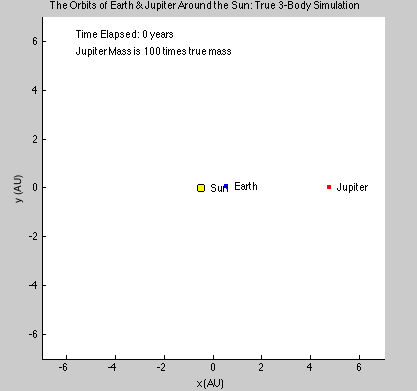
One of the first things we noticed was extreme sensitivity to initial conditions. In the following two gifs, the mass of Jupiter is multiplied first by 710x, and second by 710.2x. As you can see, this difference of .2 yields a largely different path for the Earth. In fact, it seems that the results from this section are much closer to the chaotic regime than expected due to their sensitivity. This observation might have some insight into why these systems are so hard to calculate in general.
In exploring the effects of different initial conditions, we set the initial velocity of the Sun to zero. We observed the Sun to follow a cusped path, which seemed almost unnatural. Is this even possible? This also made us realize we need to establish a deeper understanding of the implications of giving the Sun an initial velocity.
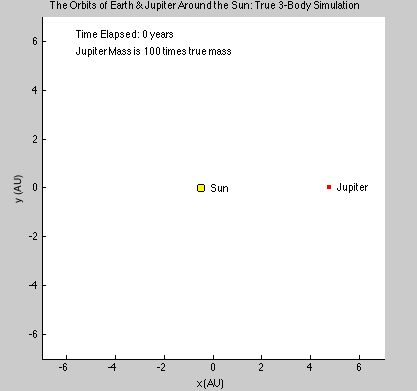
These investigations have revealed another discussion we were not expecting to find: how do we know these simulations are correct? Or, how do we know the effects we are observing are not artifacts of the numerical approximation or specific lines of code introducing error? Looking forward to next week we need to investigate ways we can can validate our code and results in order to find them meaningful. It is important to have a fundamental understanding of the underlying physics relating to a theoretical model otherwise there will be no intuition regarding the correctness of the outcome. Our initial exploration of these models yielded powerful results, yet we hope to finalize this project by reaching a greater conclusion about the nature of computational approximations of multi-body systems.
Click the two Matlab Icons below to download the Jupiter-Earth and 3-Body Orbit routines:

